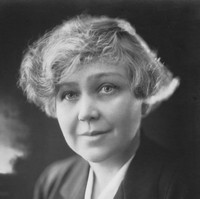Helen Mary Mayo was born in Adelaide, South Australia, on 1st October 1878, the daughter of civil engineer George Gibbes Mayo and his wife Henrietta Mary (née Donaldson). She was educated privately and at the Advanced School for Girls, matriculating in 1895. She began medical studies in 1898 and won several prizes and scholarships before graduating in 1902. After a year at the Adelaide Hospital she went to England and until 1906 worked mainly in women’s and children’s health in London, Dublin and Delhi.
Returning to Adelaide, she entered private practice and was Honorary Anaesthetist at the Adelaide Children’s Hospital. In 1909 she was a foundation member of the Women’s Non-Party Political Association and through that body put pressure on Adelaide’s Central Board of Health to initiate the reform of laws relating to mothers and babies. In 1909 she and social worker Harriet Stirling established the Adelaide School for Mothers, designed to reduce the disturbingly high infant mortality rate by teaching mothers how to care for babies, particularly in the first year of life. This became the highly effective Mothers’ and Babies’ Health Association in 1927.
In 1911 she was appointed Clinical Bacteriologist at the Adelaide Hospital where she established a vaccine department. She held this appointment for 22 years and the experience provided material for a thesis for which she was awarded the degree of Doctor of Medicine in 1926, the first M.D. awarded to a woman by the University of Adelaide. In 1914 she was the first woman to be elected to the Council of the University and she served for 46 years.
During the First World War Dr. Mayo called a meeting of doctors whose practice included paediatrics to discuss the problem of medical patients under the age of two who were not admitted to hospital because of the risk of cross-infection. The Hospital Board refused the doctors’ offer to pay for a babies’ ward to be built in the grounds, so the doctors established their own babies’ hospital in Winchester Street, St. Peter’s. A few years later the government took over the hospital and transferred it to Woodville, where in 1917 it became the Mareeba Babies Hospital. Dr. Mayo was appointed Honorary Responsible Medical Officer.
In 1919 she was appointed Honorary Assistant Physician in charge of out-patients at the Adelaide Children’s Hospital. The M.D. qualification led to her appointment as Physician to In-patients in 1926 when she also began an eight-year appointment at the University as Clinical Lecturer in the medical diseases of children. During the Second World War, although past retirement age, she set up a donor service for the Red Cross Transfusion Service, returned to duties at the Children’s Hospital and in 1943 was appointed to a committee advising the government on post-war health services. Attempts in the late 1930s to establish a women’s university college were not realized until 1947 when St. Ann’s College was opened, Dr. Mayo having served as Chairman of the original committee since 1939.
Her many honours included Fellow of the Royal Society of Medicine (1920), O.B.E. (1935), foundation Fellow of the Royal Australasian College of Physicians (1938) and President of the Australian Federation of University Women (1939-45).
Helen Mayo was short and plump, with dark curly hair and an infectious laugh. She had a strong social conscience and the energy and tenacity to achieve her objectives. She never married but shared a house at North Adelaide with her partner, Dr. Constance Finlayson, and Miss Gertrude Young. She died on 13th November 1967 and was cremated. A portrait by William Dargie hangs at St. Ann’s College, where the main hall is named in her honour.
Denholm, D., ‘A Very Remarkable Woman: Dr. Helen Mary Mayo, 1878-1967’, University of Adelaide Library News 13(1), July 1991.
Mackinnon, A., The New Women: Adelaide’s early women graduates (Netley: Wakefield Press, 1986).
Mayo, H., ‘Some Aspects of the History of Infant Welfare in South Australia’, Medical Journal of Australia, 18 June 1960.
South Australian Medical Women's Society, The hands of a woman: Stories of South Australian medical women and their society (Kent Town: Wakefield Press, 1994).




Add your comment